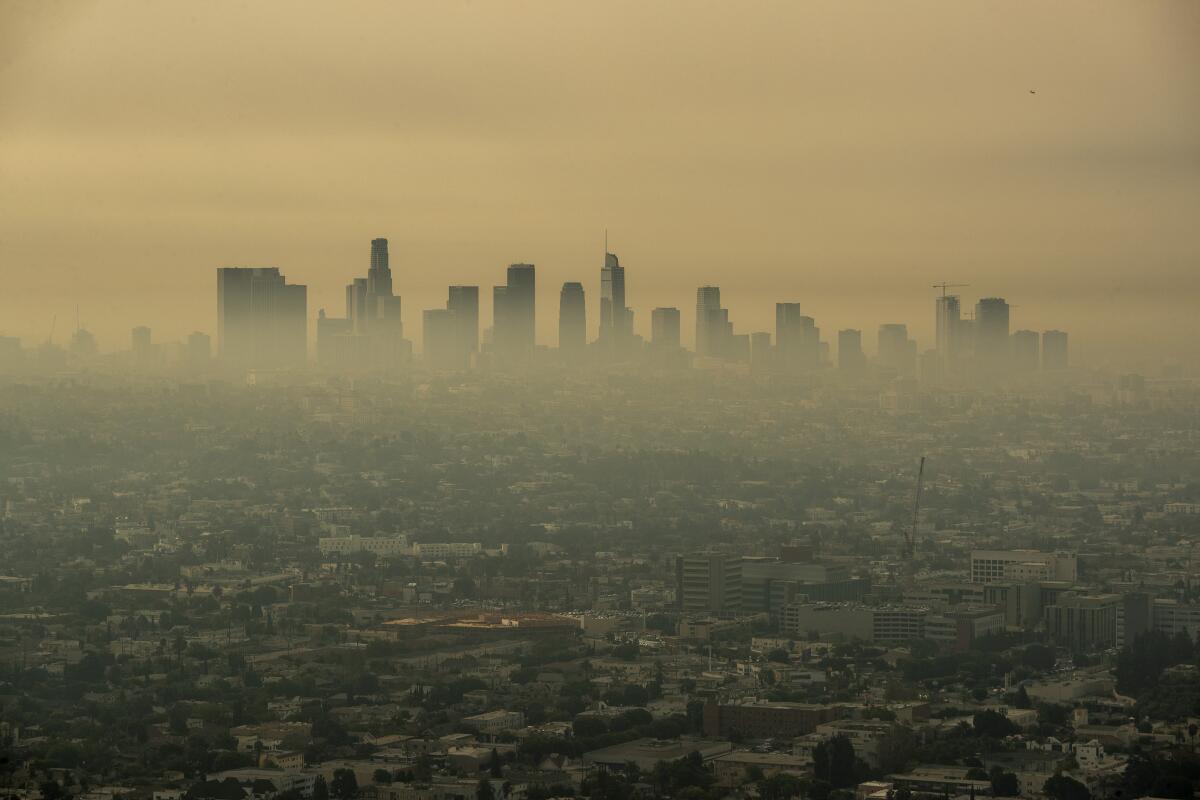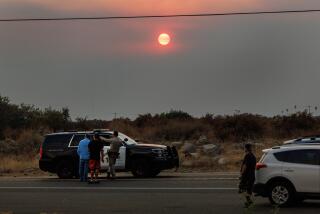Editorial: SoCal is losing its fight against smog. Things have to turn around in 2021

For a brief moment this year, Southern Californians got a glimpse of what clean air could look and feel like. During the first COVID-19 pandemic shutdowns in the spring, the dramatic drop in vehicle pollution combined with stormy weather to help clear out the region’s notoriously smoggy, hazy air, leaving blue skies and crisp vistas.
It didn’t last long. In fact, 2020 ended up being one of Southern California’s smoggiest years in decades, The Times’ Tony Barboza recently reported. There were 157 days when the region exceeded the federal health standard for ozone pollution, the main ingredient in smog. That’s the most since 1997. The region has also had more than 30 days of excessive fine-particle pollution, or soot.
The overages weren’t a fluke. Southern California’s air quality has been on the decline for several years now, with the worst effects felt in San Bernardino, Riverside and other inland communities. Despite decades of emissions control regulations and programs, the region is losing the fight for clean air. Far too many residents still live with unhealthy levels of pollution that can permanently damage children’s lungs and raise adults’ risk of heart attacks and strokes.
The region will not meet a Clean Air Act deadline to reduce ozone levels by the end of 2022, which could lead to the loss of federal transportation funding and other penalties. Even more troubling, the trend line suggests Southern California will struggle to cut smog-forming emissions enough to meet a more stringent 2031 standard. The increase in unhealthful air appears to be linked to hotter weather — heat and sunlight transform certain pollutants into ozone — and smoke from wildfires. Climate change is driving both factors, and they’re only going to become more pronounced in the coming years.
Southern California has to turn the tide on air pollution. It won’t be easy, but 2021 will be a crucial year to adopt new regulations and policies that set the region on the course for clean air. The coming year will also test the South Coast Air Quality Management District, the region’s air quality regulator. The district’s governing board, which is made up of local elected officials, has too often bent to industry demands and delayed necessary regulations to cut emissions. Now those policies are coming up for a vote.
One of the most important regulations will target oil refineries. The proposed rule would get rid of an ineffective cap-and-trade-like system for curtailing refinery pollution and instead require these facilities to install the best available pollution control equipment. This proposal has been on the table for more than five years, but the oil industry has fought successfully to delay it — and it’s likely to lobby to weaken the current proposal. But the AQMD board has to realize there is no more time to waste. The rule, which would affect about 10 refineries, would cut more smog-forming emissions than any other regulation being considered by the district.
The AQMD board will also consider a first-of-its-kind regulation to cut pollution associated with warehouses. The goods movement industry is a huge source of emissions in the region, from diesel-belching cargo ships at the ports of Los Angeles and Long Beach to the trucks and trains that haul containers to warehouses in the Inland Empire and beyond. The district has direct authority to regulate stationary sources of pollution, such as power plants, factories and refineries. But more than 80% of the region’s smog-forming pollution is created by vehicles, particularly diesel trucks, which are regulated by the state and federal governments.
Although the AQMD may not be able to regulate trucks directly, it can — and should — regulate facilities that are magnets for them. The proposed rule would require warehouses to reduce the emissions associated with their facilities by, for example, installing electric vehicle charging stations, buying low-emission or zero-emission equipment and encouraging their freight customers to use clean trucks. Again, the proposal is likely to face strong pushback from the logistics industry. But the AQMD board shouldn’t be swayed. E-commerce has boomed during the pandemic. This is an industry that can afford to pay more to help clean the air it is tainting in the smoggiest region of the country.
Likewise, the ports of Los Angeles and Long Beach delayed implementation of a fee on cargo that was supposed to help pay for cleaner trucks, citing the economic uncertainty of the pandemic. The ports now have record traffic; there’s no reason to wait on the fee or the transition to cleaner transport.
Southern California cannot solve its smog problem alone. The California Air Resources Board and the U.S. Environmental Protection Agency are crucial partners because they regulate the region’s biggest polluters. The EPA under the Trump administration largely abandoned its clean-air responsibilities; we hope the incoming Biden administration will recognize how much Southern California needs an ally in the effort to shift to a zero-emissions future.
We’ve seen how beautiful that future can be. Regulators need to step up to help make it a reality.
More to Read
A cure for the common opinion
Get thought-provoking perspectives with our weekly newsletter.
You may occasionally receive promotional content from the Los Angeles Times.










